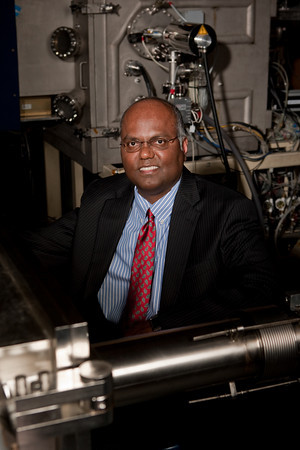
The University of Houston will lead plans for an Advanced Superconductor Manufacturing Institute (ASMI), aimed at speeding the full commercialization of high-temperature superconductors. Energetics Inc. will support UH in this effort.
Venkat Selvamanickam, M.D. Anderson Chair Professor of Mechanical Engineering at UH, will serve as principal investigator for a $500,000 planning grant from the National Institute of Standards and Technology (NIST). The grant will be used to develop an industry-led consortium to address technical obstacles that have limited superconductor manufacturing, as well as to develop a business plan for the institute.
Selvamanickam also is director of the Applied Research Hub at the Texas Center for Superconductivity at UH, which develops high-performance superconducting wire, with support from the U.S. Department of Energy, Office of Naval Research, Army Research Laboratory, National Science Foundation, the state of Texas and industry.
The NIST grant was announced this week, part of the second round of funding provided by NIST’s Advanced Manufacturing Technology Consortia, which launched in 2013 to address expanding advanced manufacturing in the United States.
The University of Houston was one of 16 recipients of the NIST planning grant, among 118 applicants in a competitive selection process.
Ramanan Krishnamoorti, chief energy officer at UH and acting vice president/vice chancellor for research and technology transfer, noted the University’s role in fundamental advances of high-temperature superconductors over the past 25 years.
“Under the leadership of Dr. Selvamanickam, with our partners in the Advanced Superconductor Manufacturing Institute, I anticipate a revolution in the scalable manufacturing of low cost, high performance superconductors,” Krishnamoorti said.
Supporters of the proposed institute, including companies prominent in the superconductor industry, spent almost two years laying the groundwork for ASMI in a UH-led effort catalyzed by Rathindra Bose, then UH vice president for research and technology transfer. Selvamanickam said the next 18 months will be used to build a consortium of industry, academia and others and to develop plans to address the roadblocks to low-cost, high-volume production, quality assurance and reliability testing.
Workforce development and integrating the technology into existing infrastructure also will be addressed.
Selvamanickam said the UH Energy Research Park, established in 2010 near the main campus to house industry-driven university research and related projects, would be an ideal location for the manufacturing institute, although the ultimate decision will be made by consortium members.
Lightweight and powerful, superconductor devices are used in energy, health care and transportation, among other uses, and offer advantages over conventional technology, including increased efficiency and reduced greenhouse gas emissions. For example, they can yield up to five percent in electricity savings in electric motors and transmission and distribution equipment.
Selvamanickam said the consortium will determine how to address the technical barriers blocking the move from today’s small-volume manufacturing to full commercialization. The group also will establish a business plan; while the institute would be started with federal funding, it is intended to become self-supporting.
His expertise with superconductors, and that of other researchers at the Texas Center for Superconductivity, can guide the consortium.
“But it’s not what I think is important,” Selvamanickam said. “It’s what industry needs.”
The United States has five Advanced Manufacturing Institutes but none involve superconductor technology. None of the planning consortiums funded in 2014, the first year the grants were awarded, deal with superconductor technology, either.